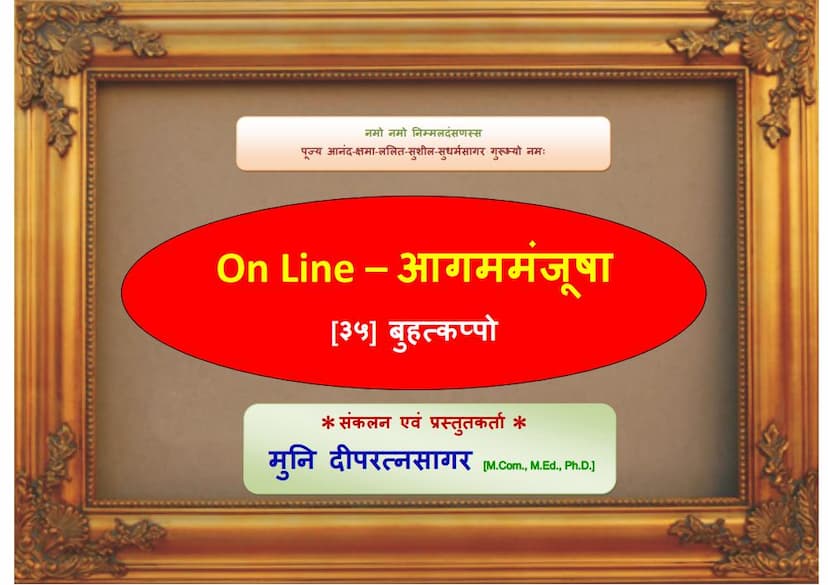Aagam Manjusha 35 Chheyasuttam Mool 02 Buhatkappo
Added to library: September 1, 2025

Summary
Here's a comprehensive summary of the provided Jain text, "Aagam Manjusha 35 Chheyasuttam Mool 02 Buhatkappo," based on the supplied pages:
Book Title: Aagam Manjusha 35 Chheyasuttam Mool 02 Buhatkappo Author(s): Anandsagarsuri, Sagaranandsuri (with Munishri Deepratnasagar as compiler/presenter of the online edition) Publisher: Deepratnasagar Catalog Link: https://jainqq.org/explore/003935/1
Overall Context:
This document is an excerpt or portion of a Jain Agam (sacred scripture), specifically focusing on the Brihatkalpa Sutra (also referred to as "Buhatkappo" in the title and text). The text deals with the rules and regulations (Kalpa) governing the conduct of ascetics, both male (Nigranthas) and female (Nigranthis), within the Jain monastic tradition. The provided pages are from an online edition of the Aagam Manjusha, compiled and presented by Munishri Deepratnasagar, which is a continuation and digitization of a work originally edited by Acharya Shri Anandsagarsuri 70 years prior.
Key Themes and Content Covered in the Provided Pages:
The pages contain detailed pronouncements on what is permissible (Kappai) and what is not permissible (No Kappai) for Jain monks and nuns in various situations. The primary focus is on the rules of conduct, specifically related to:
-
Food and Acceptance of Alms: A significant portion of the text details the proper and improper ways of accepting food (alms) from householders. This includes rules about:
- Types of food: What can and cannot be accepted (e.g., raw fruits, prepared foods).
- Conditions of acceptance: Whether the food is prepared with awareness, if it's mixed with other things, or if it's offered from specific parts of a house or by specific individuals.
- Timings of acceptance: Rules regarding acceptance at different times of the day or night.
- Methods of offering: Whether the food is offered directly or through intermediaries.
- Food prepared with specific ingredients or in specific containers: Rules concerning food offered in pots, vessels, or with particular substances.
-
Dwelling Places (Upashraya): The text outlines guidelines for where monks and nuns can reside, particularly in relation to:
- Condition of the dwelling: Whether the dwelling is suitable for habitation based on its cleanliness, occupancy, or illumination.
- Activities within the dwelling: Prohibitions on certain activities like studying, meditation, or answering calls of nature within inappropriate areas.
- Seasonal considerations: Rules about dwelling during different seasons like winter and summer.
-
Clothing and Utensils: The scripture details the types of clothing and personal items that are permitted or prohibited for ascetics. This includes:
- Materials and conditions of clothing: Rules about the state of clothing (e.g., new, old, patched, clean, dirty).
- Items of clothing: What types of garments are allowed.
- Acceptance of items: Rules regarding the acceptance of clothing, alms bowls, whisks (rajoharan), and dusters (mukharika).
-
Behavior and Conduct: The text addresses various behavioral aspects:
- Movement and Travel: Rules about traveling in groups, entering or leaving settlements, and the permissible distances for travel.
- Interaction with Laypeople: Guidelines on how to interact with householders, accept offerings, and avoid improper associations.
- Personal Conduct: Rules about bathing, cleaning, and maintaining personal hygiene.
- Prohibited Actions: Several sections list actions that are strictly forbidden, often leading to expiation (Prayashchitta) or expulsion from the monastic order. Examples include improper sexual conduct, accepting food after sunset, and consuming food that is impure or tainted.
-
Expiation and Penalties: The text frequently mentions consequences for violating the rules, such as "Chaummasik Parishuddhi" (a form of penance or purification lasting four months) or "Antara Chhed" or "Parihara" (more severe forms of expiation or expulsion).
-
Specific Rules for Monks and Nuns: There are distinctions made between the rules applicable to male monks (Nigranthas) and female nuns (Nigranthis) in certain contexts.
Structure and Presentation:
The text is presented in the form of sutras (verses), often numbered with specific references (e.g., "10021", "1036"). The language is Prakrit, the ancient language of the Agams. The provided pages seem to be a direct transcription of the original Prakrit text, possibly with some contextual numbering or references.
The "Aagam Manjusha" Project:
The introductory notes on Page 2 highlight that the "Aagam Manjusha" project aims to present Jain scriptures online. The original edition was compiled 70 years prior, and this new online version (from 2012) incorporates some useful changes, including the inclusion of Niryukti (commentaries/explanations) with original sutras for some texts and the inclusion of the commentary for the "Panchakalpa" Sutra. This indicates a continuous effort to make these ancient texts accessible.
In essence, the provided pages of the Brihatkalpa Sutra serve as a detailed "rulebook" for Jain ascetics, offering specific directives and prohibitions to guide their spiritual practice and ensure adherence to the prescribed code of conduct (Kalpa).